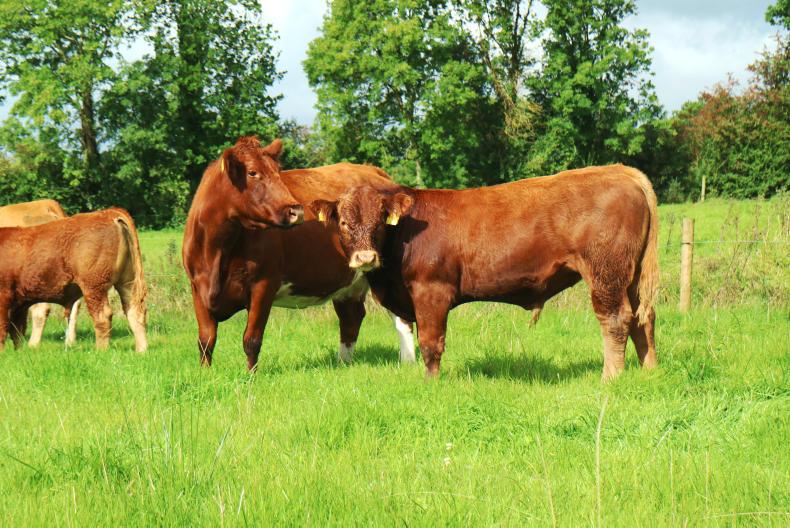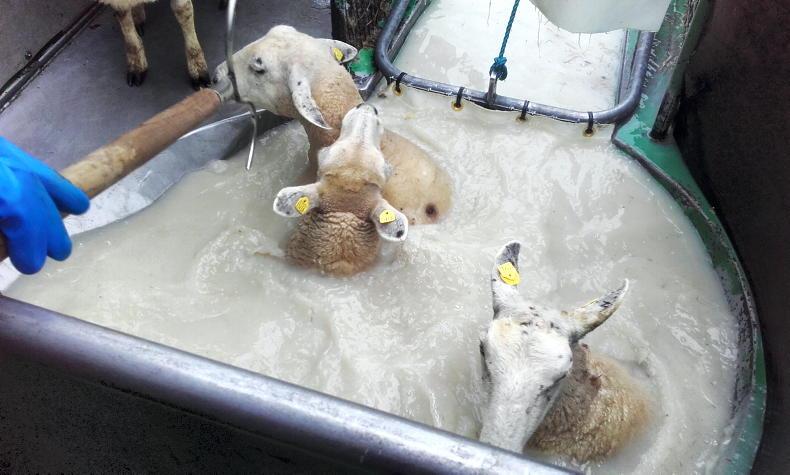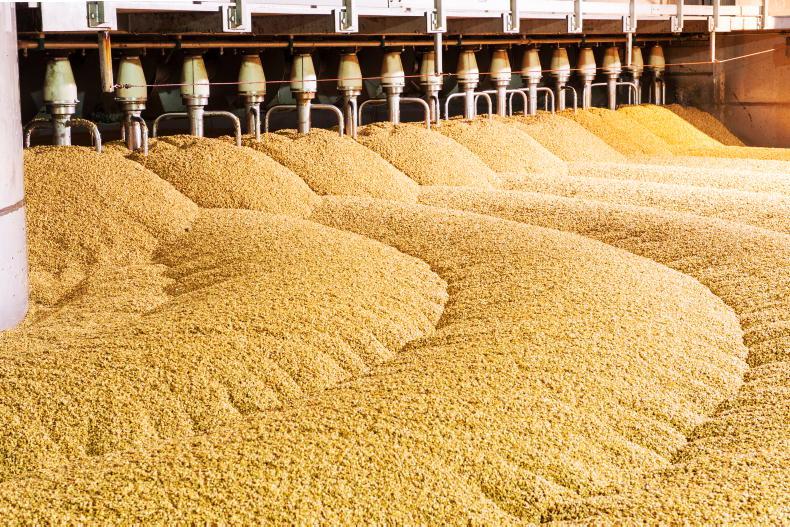The Irish suckler cow is constantly rolling with the punches – branded as being too expensive, bad for the environment and inefficient. However, the huge contrasts within the suckler herd here mean it is not accurate to use such a sweeping statement to label Ireland’s 1m cows. When the goal is improvement, variation within a population is a good thing – it shows potential.
Last year the Irish Farmers Journal visited Neil Rowe, former nominee for British Beef Farmer of the Year. Neil had grown a herd of 150 beef cows that had a tiny labour requirement and excellent feed efficiency, without sacrificing output. He had an interesting motto: “Suckler cows are not inefficient, bad decision-making leads to inefficiency.”
In some of the world’s biggest beef-producing countries, this philosophy holds.
Here, cows are constantly scrutinised throughout the production cycle. Calving ease, docility, functionality, health, fertility and calf performance are all variables upon which cows are compared, with a zero-tolerance policy for substandard animals. While these measurements are used here in Ireland, it is on a relative minority of farms.
A combination of hard selection for the above traits and good herd management over time produces excellent breeding cow herds and allows farmers to become more pedantic when making selection decisions. Also, harsh climates and scare feed in many traditional beef-producing nations mean that a big cow with poor feed efficiency will find it hard to thrive. However, by selecting for smaller genetics, we are are at risk of negatively affecting our calf output.
Weaning efficiency farm case studies
This is where the weaning efficiency measure comes in.
Weaning efficiency is simply the percentage of a cow’s own weight that she has produced in the form of a calf at 200 days. Ideally, we take a cow’s weight in mid- to late-lactation, before she has had a chance to regain all of the condition lost during her dry period and early lactation – a typical Irish suckler cow can undergo body weight fluctuations of 60kg to 70kg in a single year.
The gold standard used internationally is 50%. Any herd, be it in Ireland or abroad, with an average of 50% will be operating at a phenomenal level of technical efficiency.
Two things will drive this figure, boosting cow weight gain and pulling down cow liveweight. We must be careful that we don’t achieve all of our weaning efficiency improvements from the latter, but cow liveweight is definitely an area in which the Irish suckler herd can improve. This does not mean that we all should move away from continental breeds as an industry. One of our case study farmers, Sean Hayes, proves this.
It costs between €600 and €700 annually to maintain the Irish suckler cow and 65% of these costs go towards feed. When we compare a 650kg beef cow with a 750kg animal, the latter has a 12% higher energy requirement for maintenance. In feeding terms, assuming we can keep meals out of the diet and a winter period lasts 135 days, we save €1,600 on feed in a 50-cow herd by having the smaller cow model.
Last year, in the Irish Farmers Journal’s €150/cow challenge, we attempted to improve net margin per cow on a theoretical suckler farm operating at national average standards. Pre-weaning performance was one of the areas examined and the case study of a Meath suckler herd was used to demonstrate the importance of milk production potential in cows. Using the breeding sub-indexes, all else being equal, selection for cow milkability leads to a 140g daily increase in calf growth rate pre-weaning. At eight months of age, the difference was 34kg of liveweight and costing this at €2.60/kg improved margin by €89/cow, or €4,450 in the above 50-cow herd.
One area we will be hearing more and more about in the coming years is carbon emissions, and the suckler cow’s supposed failings in this area are well chronicled at this stage. However, there is plenty of scope to improve this too. Across 18 spring-calving BETTER beef farms in 2017, average cow weight was 652kg and weaning efficiency was 42%. However, the range went from 36% all the way to 49%. Based on Teagasc research into suckler beef carbon emissions, if we were drive this figure to 48% principally by improving calf pre-weaning growth rate, lifetime greenhouse gas emissions per kg beef (CO2 equivalents) would potentially decrease by 6%.
New report
In 2017, the ICBF in collaboration with the Irish Farmers Journal and Teagasc worked in conjunction with the BETTER farm beef participants to produce a Weaning Performance Report that has since been sent to 2,000 eligible Irish suckler farmers. The report is based on calves born in the year prior to 1 July 2017.
In section 1 of the report, the top and bottom calves from a weight gain point of view are ranked, as are their sires and dams. To be eligible for the report, calves must have at least one weight recorded on the ICBF database between 100-300 days.
While cow weights are not compulsory for the report to be generated, the weaning efficiency section (section 2) will not be included without them. Cows must have at least one weight recorded between 0-300 days of the calf’s date of birth to be included in the report.
Section 2 of ICBF’s Weaning Performance Report lists a calf’s projected 200-day weight, their average daily gain, their dam replacement index and weight and her weaning efficiency percentage. The section is broken into male and female calves and, within these, animals are ranked from highest to lowest daily weight gain. Straightaway, a farmer can see their best- and worst-performing cows and has all the necessary information for comparing cows right in front of him or her. Twins are accounted for too.
In section three of the report, a list of calves excluded from the report is included, as are the reasons for this – incorrect weights, not weighed between 100 days and 300 days, died before 100 days of age etc.
At the moment, a mart weight taken within the window above will meet the criteria for a necessary calf weight figure for the purpose of the report. However, given the differences between mart and on-farm weights, as more farmers buy into weighing their animals, the use of mart weights in generating the weaning efficiency report may be phased out.
Weighing
The ICBF currently offers an on-farm weight recording service. The €60 callout fee includes the weighing of up to 15 cattle. Thereafter, it’s €2.50 per head for 16 to 30 animals, €1.25 per head for 31 to 100 animals and €1.00 per head for 101 to 200 animals. There are discounts where discussion groups sign up to the service. All weights are keyed straight into the system by the technician and the farmer receives a printout before he/she has left the yard. This includes weights, rates of gain and predicted weights.
Comment - Chris Daly, ICBF
Aside from the management benefits of on-farm weighing, it is also hugely beneficial to the €uro-Star Indexes. There are 17 individual traits in the €uro-Star replacement index and liveweights have an impact on a number of these, most notably, milk and cow liveweight. These two traits are highly heritable (heavily influenced by genetics), meaning a relatively small number of records can have a big impact on a cow’s replacement index value and reliability. Recording on-farm weights on suckler cows and calves every year will result in much more accurate €uro-Star figures on suckler cows.
Weaning performance reports were generated for just over 4,000 herds, in which 52,000 calves and 14,000 cows had weights recorded. The table below details the performance of cows by replacement index star rating as well as the national average figures.
Five-star cows performed best on all of the traits outlined. They produced the heaviest calves at 200 days, while the cows themselves were lightest, leading to a higher cow weaning efficiency percentage.
The Weaning Performance Report is available to all suckler farmers availing of the ICBF HerdPlus service. Farmers can generate a new report having recorded weights. This can be done through the reports section once logged into HerdPlus. You simply select a date range for calf date of birth and click ‘Generate Report’. A new report will be generated in 10-15 seconds.
Read more
HerdPlus beef farmers escape fee hike
Breeding Initiatives, Tullamore Farm and slurry
The Irish suckler cow is constantly rolling with the punches – branded as being too expensive, bad for the environment and inefficient. However, the huge contrasts within the suckler herd here mean it is not accurate to use such a sweeping statement to label Ireland’s 1m cows. When the goal is improvement, variation within a population is a good thing – it shows potential.
Last year the Irish Farmers Journal visited Neil Rowe, former nominee for British Beef Farmer of the Year. Neil had grown a herd of 150 beef cows that had a tiny labour requirement and excellent feed efficiency, without sacrificing output. He had an interesting motto: “Suckler cows are not inefficient, bad decision-making leads to inefficiency.”
In some of the world’s biggest beef-producing countries, this philosophy holds.
Here, cows are constantly scrutinised throughout the production cycle. Calving ease, docility, functionality, health, fertility and calf performance are all variables upon which cows are compared, with a zero-tolerance policy for substandard animals. While these measurements are used here in Ireland, it is on a relative minority of farms.
A combination of hard selection for the above traits and good herd management over time produces excellent breeding cow herds and allows farmers to become more pedantic when making selection decisions. Also, harsh climates and scare feed in many traditional beef-producing nations mean that a big cow with poor feed efficiency will find it hard to thrive. However, by selecting for smaller genetics, we are are at risk of negatively affecting our calf output.
Weaning efficiency farm case studies
This is where the weaning efficiency measure comes in.
Weaning efficiency is simply the percentage of a cow’s own weight that she has produced in the form of a calf at 200 days. Ideally, we take a cow’s weight in mid- to late-lactation, before she has had a chance to regain all of the condition lost during her dry period and early lactation – a typical Irish suckler cow can undergo body weight fluctuations of 60kg to 70kg in a single year.
The gold standard used internationally is 50%. Any herd, be it in Ireland or abroad, with an average of 50% will be operating at a phenomenal level of technical efficiency.
Two things will drive this figure, boosting cow weight gain and pulling down cow liveweight. We must be careful that we don’t achieve all of our weaning efficiency improvements from the latter, but cow liveweight is definitely an area in which the Irish suckler herd can improve. This does not mean that we all should move away from continental breeds as an industry. One of our case study farmers, Sean Hayes, proves this.
It costs between €600 and €700 annually to maintain the Irish suckler cow and 65% of these costs go towards feed. When we compare a 650kg beef cow with a 750kg animal, the latter has a 12% higher energy requirement for maintenance. In feeding terms, assuming we can keep meals out of the diet and a winter period lasts 135 days, we save €1,600 on feed in a 50-cow herd by having the smaller cow model.
Last year, in the Irish Farmers Journal’s €150/cow challenge, we attempted to improve net margin per cow on a theoretical suckler farm operating at national average standards. Pre-weaning performance was one of the areas examined and the case study of a Meath suckler herd was used to demonstrate the importance of milk production potential in cows. Using the breeding sub-indexes, all else being equal, selection for cow milkability leads to a 140g daily increase in calf growth rate pre-weaning. At eight months of age, the difference was 34kg of liveweight and costing this at €2.60/kg improved margin by €89/cow, or €4,450 in the above 50-cow herd.
One area we will be hearing more and more about in the coming years is carbon emissions, and the suckler cow’s supposed failings in this area are well chronicled at this stage. However, there is plenty of scope to improve this too. Across 18 spring-calving BETTER beef farms in 2017, average cow weight was 652kg and weaning efficiency was 42%. However, the range went from 36% all the way to 49%. Based on Teagasc research into suckler beef carbon emissions, if we were drive this figure to 48% principally by improving calf pre-weaning growth rate, lifetime greenhouse gas emissions per kg beef (CO2 equivalents) would potentially decrease by 6%.
New report
In 2017, the ICBF in collaboration with the Irish Farmers Journal and Teagasc worked in conjunction with the BETTER farm beef participants to produce a Weaning Performance Report that has since been sent to 2,000 eligible Irish suckler farmers. The report is based on calves born in the year prior to 1 July 2017.
In section 1 of the report, the top and bottom calves from a weight gain point of view are ranked, as are their sires and dams. To be eligible for the report, calves must have at least one weight recorded on the ICBF database between 100-300 days.
While cow weights are not compulsory for the report to be generated, the weaning efficiency section (section 2) will not be included without them. Cows must have at least one weight recorded between 0-300 days of the calf’s date of birth to be included in the report.
Section 2 of ICBF’s Weaning Performance Report lists a calf’s projected 200-day weight, their average daily gain, their dam replacement index and weight and her weaning efficiency percentage. The section is broken into male and female calves and, within these, animals are ranked from highest to lowest daily weight gain. Straightaway, a farmer can see their best- and worst-performing cows and has all the necessary information for comparing cows right in front of him or her. Twins are accounted for too.
In section three of the report, a list of calves excluded from the report is included, as are the reasons for this – incorrect weights, not weighed between 100 days and 300 days, died before 100 days of age etc.
At the moment, a mart weight taken within the window above will meet the criteria for a necessary calf weight figure for the purpose of the report. However, given the differences between mart and on-farm weights, as more farmers buy into weighing their animals, the use of mart weights in generating the weaning efficiency report may be phased out.
Weighing
The ICBF currently offers an on-farm weight recording service. The €60 callout fee includes the weighing of up to 15 cattle. Thereafter, it’s €2.50 per head for 16 to 30 animals, €1.25 per head for 31 to 100 animals and €1.00 per head for 101 to 200 animals. There are discounts where discussion groups sign up to the service. All weights are keyed straight into the system by the technician and the farmer receives a printout before he/she has left the yard. This includes weights, rates of gain and predicted weights.
Comment - Chris Daly, ICBF
Aside from the management benefits of on-farm weighing, it is also hugely beneficial to the €uro-Star Indexes. There are 17 individual traits in the €uro-Star replacement index and liveweights have an impact on a number of these, most notably, milk and cow liveweight. These two traits are highly heritable (heavily influenced by genetics), meaning a relatively small number of records can have a big impact on a cow’s replacement index value and reliability. Recording on-farm weights on suckler cows and calves every year will result in much more accurate €uro-Star figures on suckler cows.
Weaning performance reports were generated for just over 4,000 herds, in which 52,000 calves and 14,000 cows had weights recorded. The table below details the performance of cows by replacement index star rating as well as the national average figures.
Five-star cows performed best on all of the traits outlined. They produced the heaviest calves at 200 days, while the cows themselves were lightest, leading to a higher cow weaning efficiency percentage.
The Weaning Performance Report is available to all suckler farmers availing of the ICBF HerdPlus service. Farmers can generate a new report having recorded weights. This can be done through the reports section once logged into HerdPlus. You simply select a date range for calf date of birth and click ‘Generate Report’. A new report will be generated in 10-15 seconds.
Read more
HerdPlus beef farmers escape fee hike
Breeding Initiatives, Tullamore Farm and slurry












SHARING OPTIONS